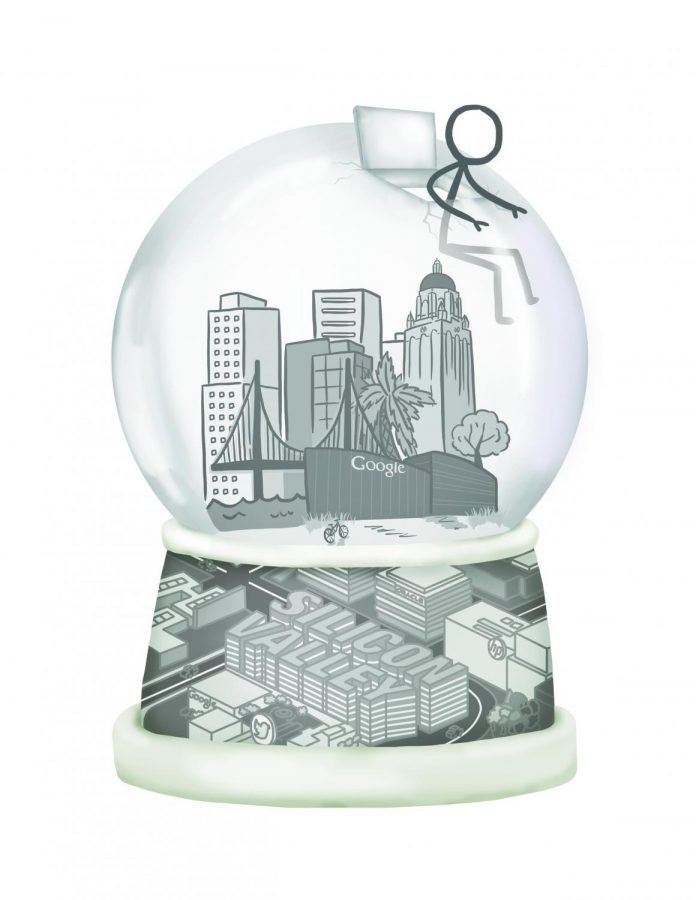Silicon Valley creates harmful culture
In 1939, Bill Hewlett and David Packard founded the Hewlett-Packard (HP) Company in a small, one- car garage located in Palo Alto. In the following years, the surrounding Silicon Valley came to be regarded as the hub of technology. As time has passed, more and more techies have moved to Palo Alto to start their own companies. Google and Facebook, two of the most visited websites on the internet, were both founded in Palo Alto. Other companies founded in Palo Alto have changed the way we spend money, eat, drive and use the internet. HP is not only a pioneer of technology, but also a recognized symbolic founder of Silicon Valley. The influx of wealth and talent that this tech boom attracted has led to a cultural “bubble” unlike any other in the world.
The cultural “bubble” of Palo Alto is fast-paced, high-achieving and expensive. Many of the companies created here have pioneered their specific field and transformed the way we live our lives. Companies such as Paypal, DoorDash and Waze were all created to make everyday tasks easier. These companies, however, come at an expense. With the need for more employees to create new products, people are moving to Palo Alto from all over the world. There is just one problem: there is only so much housing available. Due to the limited amount of housing, the home value in Palo Alto is higher than almost every other city in the United States. Zillow. com reports that the median home value in Palo Alto is $3,270,200. Being surrounded by affluent living can blind residents to widespread poverty in America; this limited exposure contributes to a very specific lifestyle.
Palo Alto’s “bubble” is also full of high-achieving individuals that are well- known across the world. Los Angeles has celebrities, and Palo Alto has technology moguls. People such as Larry Page, Tim Cook, Marissa Mayer and Mark Zuckerberg all reside in Palo Alto. This technology-driven town is the only place you can trick- or-treat at the late Steve Jobs’ house on Halloween, run into Mark Zuckerberg at the local noodle house or sit behind Sheryl Sandberg at a Stanford gathering. Another example of Silicon Valley’s high-achieving “bubble” is the fact that Palo Alto is known to have one of the most educated populations in the country. With Stanford’s 16,940 students, there is no shortage of intellectuals roaming University Avenue. According to the World Population Review, 51.52 percent of all Palo Alto adult residents have received a graduate degree (compared to roughly 9 percent nation- ally). This large number con- tributes to the fact that some of the brightest people live in this high-achieving atmosphere. Interact- ing with these highly- educated individuals can shape the values and openmindedness of residents because there is little exposure to diverse perspectives and lifestyles.
Companies that were either founded or moved to the “bubble,” including startups and venture capital firms, have added to the fact that Palo Alto is unlike any other suburban town in the world. Tesla’s electric cars are a common sight on the streets of Palo Alto, and their headquarters are located only a mile away from one of the best public schools in the United States. These expensive cars add to the identity of Palo Alto as a leader of technology and wealth.
These positive attributes, however, can also have a negative impact on the Silicon Valley. The ultra- rich, ultra-educated and ultra-liberal “bubble” is not a true representation of the majority of the population. Cityofpaloalto.org reports that as of Jan. 1, 2019, the minimum wage will increase from $13.50 an hour to $15.00 an hour. Palo Alto’s minimum wage is double the federal minimum wage of $7.25, according to the United States Department of Labor. This difference, and many others, are reasons why it is imperative for residents of Palo Alto to experience life in the rest of the United States. Palo Alto is a sheltered, isolated suburb that does not reflect the rest of the United States, let alone the world. The views of those who never leave the area differ from that of those who do. The intense atmosphere perpetuated by the cultural “bubble” of Palo Alto is the reason why residents need to leave this area and experience the culture of other places.
Your donation will support the student journalists of Henry M. Gunn High School. Your contribution will allow us to purchase equipment and cover our annual website hosting costs.


